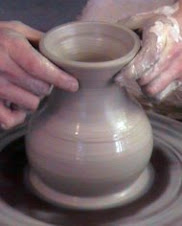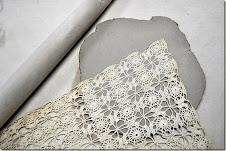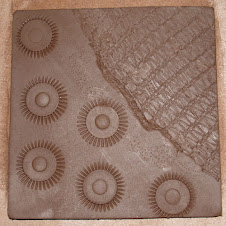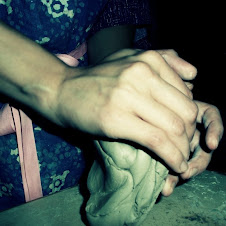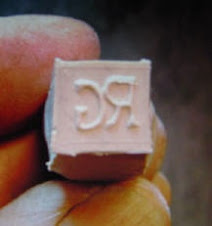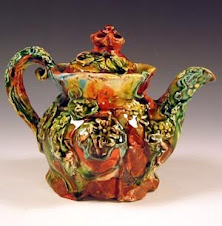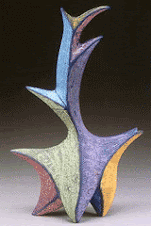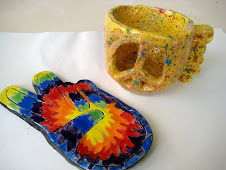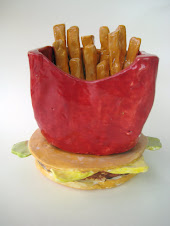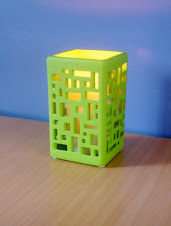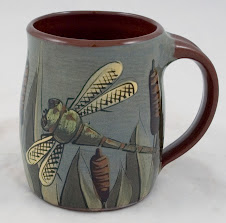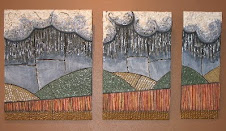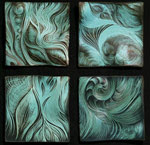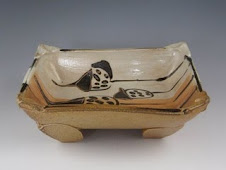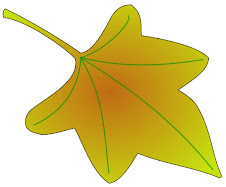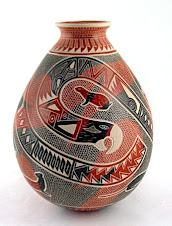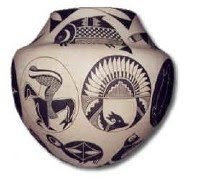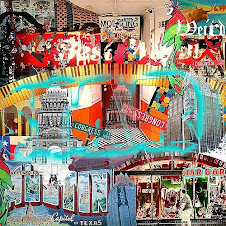Wednesday, December 21, 2011
Monday, December 12, 2011
Monday, November 28, 2011
Wednesday, November 2, 2011
Tuesday, October 11, 2011
Cup and Saucer Assignment Due Friday, October 14th
Your next project in class will be to create a cup and saucer based on a word of your choosing. This word will help you determine the colors, shapes and overall mood of your project. See the examples to the right of past students' projects!
*Your homework assignment is to choose three words that you might want to use for your cup and saucer project. *
Choose from the list below, or choose your own! Write down your three words in your sketchbook, leaving space for your sketches.
In class, we will draw out ideas for how each word could be turned into a sculpture that you might be able to use for your pinch pot project.
(If you want to start your sketches at home, you will get extra credit!!)
Remember that there is a cup and a saucer--how could you relate the two together? Think about whether you want your cup and saucer to be functional or sculptural.
acidic wiggly aggressive joyous silent tinystormy tired fluffy curly loud lovely slimyunruly precious dazzling elegant cloudy deliciousmysterious grumpy lucky puzzling enchantedancient valuable heavenly graceful dreary alivecrooked lacy rotten strange spiky poisedovergrown sleepy friendly
Monday, September 26, 2011
Thursday, September 8, 2011
For this project, you will create tiles with an image drawn, carved, pressed and/or painted onto the surface. You will need to bring in at least 3 items to press into the clay to create textures (think leaves, sticks, lace, buttons, old jewelry, etc.) Your central image will be a narrative (based on a story, true or fictional). Choose from literature, or create your own story (but you have to write it down!) You have two options for what type of tiles to create:
 Single Tile: One tile, approximately 6”x6”, square or irregular outside shape.
Single Tile: One tile, approximately 6”x6”, square or irregular outside shape.
Must include: at least 3 textures, at least one area of 3D sculpting, even background tile thickness
Multiple Tiles: Three or Four tiles, connected through a central image. Each tile is approximately 4”x4”.
Must include: at least 3 textures, at least one area of 3D sculpting , even background tile thickness
Your projects will be graded on the following:
Craftsmanship: Neatness, careful control drying (no warped tiles), glazing
Creativity: Well-planned ideas based on a story, careful application of textures
Community: How you relate to your peers, cleanup habits, attendance
Tuesday, September 6, 2011
Monday, May 9, 2011
Artist Study * Mini-Research Paper
For this paper, you will find a ceramic artist whose work you are particularly drawn to…look online, in books or magazines for inspiration. The artist can be contemporary, meaning they are alive and creating ceramic art today, or they can be from any point in history.
Print out or photocopy at least two images of your chosen artist’s work. These photos will be passed in with your paper.
The paper will be a summary of the artist’s bio as well as why you chose them and what specifically you admire about their work. This should be about 1 page: make sure you include all the information below!
-who the artist is
-important dates: birth, death (if applicable), when they were creating artwork
-where they are from, where they work(ed)
-what specific techniques do they use? types of clay/glazes, type of kiln/firing process
*hint: when you see a word you do not recognize, ex. “raku”, look it up in Google or Wikipedia and describe that in your paper!
-why you chose this artist: what drew you to their work? why do you admire this person, what about your knowledge of ceramics makes them particularly interesting?
-what connections can you make between this person’s work and your own ceramic work? are the two similar in style, concept, form or finish?or are they very different—and how did the similarities/differences influence your decision to choose this artist in particular?
Please use complete sentences, and type the paper….remember that the content is more important than the length of the paper!
*Due Friday, May 2oth*
10 extra points if passed in by May 13th
5 extra points if passed in by the 19th
Monday, April 25, 2011
Monday, March 7, 2011
Monday, February 28, 2011
Friday, February 4, 2011
Creating a Clay Stamp
1. Complete your designs for both the initial stamp and symbol stamp. Check them off with Miss Mahoney. You will put your initials on one side of your stamp, and the picture or symbol on the other.
2. Recycle and wedge a piece of clay about the size of an apple.
3. Break off a piece of this clay and begin shaping your stamp handle. Remember that the handles can be circular, square, triangular—whatever you like, but they must not be thickerthan 1”! Leave the ends wider for the images to be put onto.
4. Flatten the ends of your stamp handle so they are smooth and ready for the designs to be drawn on.
5. Trace your designs onto small pieces of tracing paper with a pencil. Then put the tracing paper pencil side down onto the flattened end. The design should appear backwards at this point. Trace over the design with your pencil or a pin tool and check to make sure the graphite has transferred onto the clay.
6. Use a pin tool to cut off the clay around your design to make the letters or picture pop up off the block, or use a carving tool to scoop out the clay inside your letters or picture to make them indent into the block.
7. Smooth out the entire stamp: this is best done when most of the carving is complete, and the stamp is leather hard. Scrape out any excess crumbs of clay, use small amounts of water to smooth the handle and surfaces of your stamp.
8. When both sides have been carved, put your name and block on the handle of the stamp (legibly), check it with Miss Mahoney, and put the stamp on the Greenware shelf to be fired!
Friday, January 28, 2011
Miss Patterson
Beginning Ceramics
Clay is an ancient medium that began as a means to create functional objects used in everyday life, and has evolved to become one of the most beautiful forms of artistic expression. In this class, you will have the opportunity to explore your creativity through the form and function of ceramics. I encourage you to take risks and develop your personal style throughout the semester.
In this class, we will study the beginning techniques of pinching, coiling and slab building. We will also practice beginning skills on the wheel. In addition to the class work, you will have weekly assignments reinforcing the techniques we are studying.
For this class you will need:
a shoebox to store clay and projects in (I have some used ones, or you can get your own)
a notebook to record outside assignments and sketch project ideas (lined, blank, leftover from Foundations…)
three plastic bags to wrap clay in--small trash bags and gallon-sized Ziploc bags work well
soap, hand lotion or tissues to contribute to the classroom
These items are due Friday, January 28th!
Grading
Your projects will be graded by the execution of the technique studied, the glaze or finish, and your written feedback on the grading sheet. You are responsible for any assignments written on the board, so check it daily! Your overall grade will be a combination of your projects, outside assignments, and effort.
Cleanup
Keeping this room clean is a matter of safety. Each artist is responsible for their own workspace as well as a weekly studio job, which will help with the general maintenance of the studio space. Completion of your cleanup jobs will factor into your effort grade.
Expectations
*You will show up on time and remain in class until the bell rings. If you need to leave, tell me. Lining up at the door before the bell shows me that you have extra time to do more cleaning!
*You will work on projects throughout the class, and clean up well every day. Your effort grade is heavily based upon everyday work habits, so make them good. No non-enrolled students are allowed in the room during class time.
*No food or drink in the room. It is unhealthy to eat in this room due to the nature of the materials we use, and this also avoids messes in the workspace.
*No Ipods or cell phones during class. This is a school rule as well as my own rule—these devices are distracting and antisocial, making it difficult for me to teach and for you to learn.
*Respect the kilns! They are almost always running, and they get very hot. Please be careful when bringing work into the kiln room
*Respect each other. Remember the Golden Rule? Your language and attitude create the atmosphere in our classroom, and make it a comfortable place to be. If you can speak in a respectful way and manage your time well while you are in this class, you will do well this semester.
Monday, January 3, 2011
Artist Study * Mini-Research Paper
Due Friday, January 14th
For this paper, you will find a ceramic artist whose work you are particularly drawn to…look online, in books or magazines for inspiration. The artist can be contemporary, meaning they are alive and creating ceramic art today, or they can be from any point in history.
Print out or photocopy at least two images of your chosen artist’s work. These photos will be passed in with your paper.
The paper will be a summary of the artist’s bio as well as why you chose them and what specifically you admire about their work. This should be about 1 page: make sure you include all the information below!
-who the artist is
-important dates: birth, death (if applicable), when they were creating artwork
-where they are from, where they work(ed)
-what specific techniques do they use? types of clay/glazes, type of kiln/firing process
*hint: when you see a word you do not recognize, ex. “raku”, look it up in Google or Wikipedia and describe that in your paper!
-why you chose this artist: what drew you to their work? why do you admire this person, what about your knowledge of ceramics makes them particularly interesting?
-what connections can you make between this person’s work and your own ceramic work? are the two similar in style, concept, form or finish? or are they very different—and how did the similarities/differences influence your decision to choose this artist in particular?
Please use complete sentences, type the paper and print it out to pass it in….remember that the content is more important than the length of the paper!
HOMEWORK DUE FRIDAY JANUARY 7TH: bring in your two printed pictures and the name of your artist so I know you have begun the research process! This will count as your 2nd homework assignment for qtr. 2. Check plus for early pass-ins, full credit for on time, partial credit for late pass-ins.
Luminary: a body that gives light, especially one of the celestial bodies (Merriam-Webster’s online dictionary)
Our ceramic luminaries will be box forms that enclose a candle, have a lid, and let out light through a series of pierced decorations.
Tie the visual theme of your luminary to a dream ...which could have occurred during sleep, or may be a wish or want while awake.
For example: a dream about flying over a city could be represented in your imagery, or you may wish to show what you wish to become after college!
Create a challenging geometric form with your slabs. Make a paper template before beginning. Control dry slabs to leather hard, bevel edges and slip and score well!
Use piercing in a thoughtful and meaningful manner: piercing should enhance and fit with the overall theme.
Use a color scheme with surface decoration that is well chosen and well applied.
